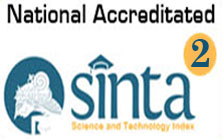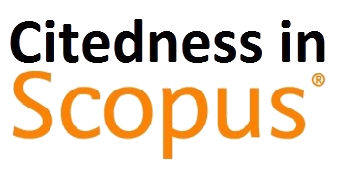Compliance Level of PAUD Students in Brushing with the Interactive Calendar Guide
DOI:
https://doi.org/10.31965/infokes.Vol21.Iss1.938Keywords:
Compliance, Morning and Evening Brushing, Interactive CalendarAbstract
Brushing teeth properly and correctly must be instilled in children from an early age so that they become accustomed to living a clean and healthy lifestyle. Dental health education can help people develop good brushing habits. Brushing your teeth in the morning and evening for 21 days is an interactive calendar designed to control the implementation of brushing your teeth in the morning and evening. The objective of this study was to assess PAUD (Pre-School) students' compliance with morning and night toothbrushing using an interactive calendar guide to brushing their teeth in the morning and evening for 21 days. The research method used is pre-experimental. Simple random sampling method was also administered. The research intervention was conducted on 32 PAUD Bahagia Sukapura and Al Abror students. A questionnaire and an interactive calendar sheet were used as research instruments. The results showed that before the intervention, the average score of PAUD children's compliance with brushing their teeth in the morning and evening was 46.9063, but after the intervention, it increased to 79.0313. Before the intervention, the level of adherence to brushing teeth in the morning and evening was in the less compliant category (40.6%), but after the intervention with an interactive calendar, it increased to (96.9%). The Wilcoxon Sign Rank Test analysis revealed a difference in pre- and post-intervention scores on children's compliance data in brushing their teeth using the morning and evening brushing calendar for 21 days, with a p-value (0.000) <0.05. Brushing their teeth twice a day in the morning and evening for 21 days is effective in increasing PAUD children's adherence to brushing their teeth twice a day in the morning and evening.
Downloads
References
Abadi, N. Y. W. P., & Suparno, S. (2019). Perspektif orang tua pada kesehatan gigi anak usia dini. Jurnal Obsesi: Jurnal Pendidikan Anak Usia Dini, 3(1), 161-169. https://doi.org/10.31004/obsesi.v3i1.161
Angelica, C., Sembiring, L. S., & Suwindere, W. (2019). Pengaruh tingkat pendidikan tinggi dan perilaku ibu terhadap indeks def-t pada anak usia 4‒5 tahun. The influence of higher education level and maternal behaviour on the def-t index in children aged 4‒5 years old. Padjadjaran Journal of Dental Researchers and Students, 3(1), 20-25 https://doi.org/10.24198/pjdrs.v3i1.22484
Arora, A., Lucas, D., To, M., Chimoriya, R., Bhole, S., Tadakamadla, S. K., & Crall, J. J. (2021). How Do Mothers Living in Socially Deprived Communities Perceive Oral Health of Young Children? A Qualitative Study. International Journal of Environmental Research and Public Health, 18(7), 3521.
https://doi.org/10.3390/ijerph18073521
Asyhar, R. (2012). Kreatif Mengembangkan Media Pembelajaran. Jakarta: Referensi.
Aulina, C. N. (2018). Penerapan Metode Whole Brain Teaching dalam Meningkatkan Motivasi Belajar Anak Usia Dini. Research & Learning in Early Childhood Education. Jurnal Obsesi : Jurnal Pendidikan Anak Usia Dini, 2(1), 1–12. https://doi.org/10.31004/obsesi.v2i1.1
Belinda, N., & Surya, L. (2021). Media Edukasi dalam Pendidikan Kesehatan Gigi dan Mulut pada Anak-anak. Jurnal Riset Intervensi Pendidikan (JRIP), 3(1), 55–60. Retrieved from http://journal.rekarta.co.id/index.php/jrip/article/view/22
Bramantoro, T., Santoso, C. M. A., Hariyani, N., Setyowati, D., Zulfiana, A. A., Nor, N. A. M., Nagy, A., Pratamawari, D. N. P., & Irmalia, W. R. (2021). Effectiveness of the school-based oral health promotion programmes from preschool to high school: A systematic review. PLOS ONE, 16(8), e0256007. https://doi.org/10.1371/journal.pone.0256007
Ceyhan, D., Akdik, C., & Kirzioglu, Z. (2018). An educational programme designed for the evaluation of effectiveness of two tooth brushing techniques in preschool children. European Journal of Paediatric Dentistry, 19(3), 181–186. https://doi.org/10.23804/ejpd.2018.19.03.3
Chandio, N., Micheal, S., Tadakmadla, S. K., Sohn, W., Cartwright, S., White, R., Sanagavarapu, P., Parmar, J. S., & Arora, A. (2022). Barriers and enablers in the implementation and sustainability of toothbrushing programs in early childhood settings and primary schools: a systematic review. BMC Oral Health, 22, 242. https://doi.org/10.1186/s12903-022-02270-7
De Jong-Lenters, M., L’Hoir, M., Polak, E., & Duijster, D. (2019). Promoting parenting strategies to improve tooth brushing in children: design of a non-randomised cluster-controlled trial. BMC Oral Health, 19, 210.
https://doi.org/10.1186/s12903-019-0902-6
De Vries, H. (2017). An Integrated Approach for Understanding Health Behavior; The I-Change Model as an Example.
Psychology and Behavioral Science International Journal, 2(2), 555585. https://doi.org/10.19080/PBSIJ.2017.02.555585
George, A., Sousa, M. S., Kong, A. C., Blinkhorn, A., Patterson Norrie, T., Foster, J., Dahlen, H. G., Ajwani, S., & Johnson, M. (2019). Effectiveness of preventive dental programs offered to mothers by non-dental professionals to control early childhood dental caries: a review. BMC Oral Health, 19, 172.
https://doi.org/10.1186/s12903-019-0862-x
Heriyanto, Y., Laela, S. D., & Mulyanti, S. (2018). Relationship Between School Dental Health Education Program Through Video and Interactive Calendar Against Changes in Tooth Brushing Behavior in Elementary School-aged Children at SDN Arcamanik Endah and SDN Mekarjaya in Bandung City and Their Families. Proceeding of The 1st International Conference on Interprofessional Health
Collaboration and Community Empowerment, 1(1), 399–401. https://conference.juriskes.com/index.php/IC/article/view/49
Kell, K., Aymerich, M.-A., & Horn, V. (2018). FDI–Unilever Brush Day & Night partnership: 12 years of improving behaviour for better oral health. International Dental Journal, 68 (Supplement 1), 3–6. https://doi.org/10.1111/idj.12404
Kementerian Kesehatan Republik Indonesia. (2019). Hasil Riset Kesehatan Dasar (Riskesdas) 2018. Jakarta: Kementerian Kesehatan Republik Indonesia.
Khan, I. M., Mani, S. A., Doss, J. G., Danaee, M., & Kong, L. Y. L. (2021). Pre-schoolers’ tooth brushing behaviour and association with their oral health: a cross sectional study. BMC Oral Health, 21, 283. https://doi.org/10.1186/s12903-021-01643-8
Lestari, R. D., Irawati, N., & Murniwati, M. (2017). Efektivitas Media pop-up card terhadap pengetahuan kesehatan gigi dan mulut anak usia 8-9 tahun. Andalas Dental Journal, 5(1), 31-39. https://doi.org/10.25077/adj.v5i1.68
Mahat, G., & Bowen, F. (2017). Parental Knowledge about Urban Preschool Children’s Oral Health Risk. Pediatric Nursing, 43(1), 30–34. http://www.ncbi.nlm.nih.gov/pubmed/29406664
Mahmoud, N., Kowash, M., Hussein, I., Hassan, A., & Al Halabi, M. (2017). Oral health knowledge, attitude, and practices of Sharjah mothers of preschool children, United Arab Emirates. Journal of International Society of
Preventive and Community Dentistry, 7(6), 308-314. https://doi.org/10.4103/jispcd.JISPCD_310_17
Manton, D. J. (2018). E Clinical Medicine Child Dental Caries – A Global Problem of Inequality. E Clinical Medicine, 1, 3–4. https://doi.org/10.1016/j.eclinm.2018.06.006
Melo, P., Fine, C., Malone, S., Frencken, J. E., & Horn, V. (2018). The effectiveness of the Brush Day and Night programme in improving children’s toothbrushing knowledge and behaviour. International Dental Journal, 68, 7–16.
https://doi.org/10.1111/idj.12410
Melo, P., Fine, C., Malone, S., & Taylor, S. (2021). Impact of the Brush Day & Night Programme on Well-Being, Plaque, and Dental Caries in Children. International Dental Journal, 71(Supplement 1), S15–S30. https://doi.org/10.1016/j.identj.2021.01.018
Melo, P., Malone, S., Rao, A., & Fine, C. (2020). A 21-Day School-Based Toothbrushing Intervention in Children Aged 6 to 9 Years in Indonesia and Nigeria: Protocol for a Two-Arm Superiority Randomized Controlled Trial. JMIR Research Protocols, 9(2), e14156. https://doi.org/10.2196/14156
Muhtar, S., Hatta, I., & Wardani, I. K. (2020). Hubungan Tingkat Pengetahuan Ibu Tentang Kesehatan Gigi Dengan Tingkat Kebersihan Gigi Dan Mulut Pada Anak Di Kabupaten Barito Kuala (Tinjauan Anak Usia 4-5 Tahun di TK Nusa Indah Berangas Kecamatan Alalak). Dentin, 4(1), 16-20. Retrieved from https://ppjp.ulm.ac.id/journals/index.php/dnt/article/view/2243
Nuraini, S. L., Rahardjo, A., & Maharani, D. A. (2021). An Indonesian Version of Child Oral Health Impact Profile-Short Form 19 (COHIP-SF19): Assessing Validity and Reliability. Journal of Dentistry Indonesia, 28(1), 45–53. https://doi.org/10.14693/jdi.v28i1.1247
Pawarti, P., & Abral, A. (2019). Penggunaan Kalender Sikat Gigi Dalam Meningkatkan Motivasi Siswa Terhadap Perilaku Menyikat Gigi. Jurnal Vokasi Kesehatan, 5(2), 103-106. Retrieved from http://ejournal.poltekkes-pontianak.ac.id/index.php/JVK/article/view/251
Rahina, Y., DIGAA, C. I., Elang, P., & Walianto, S. (2021). School Program Brush Day And Night 21 Day To Increase Awareness About Oral Health: A Qualitative Study: Program Sekolah 21 Hari Menyikat Gigi Pagi Dan Malam Untuk Meningkatkan Kesadaran Tentang Kesehatan Mulut: Studi Kualitatif. Interdental Jurnal Kedokteran Gigi (IJKG), 17(2), 110-116. https://doi.org/10.46862/interdental.v17i2.2942
Seeberger, G., & Sampietro, M. (2021). Brush Day & Night: a review of a landmark partnership for children’s oral health. International Dental Journal, 71(Supplement 1), S2–S3. https://doi.org/10.1016/j.identj.2021.01.019
Soldani, F. A., Lamont, T., Jones, K., Young, L., Walsh, T., Lala, R., & Clarkson, J. E. (2018). One-to-one oral hygiene advice provided in a dental setting for oral health. Cochrane Database of Systematic Reviews, 10(10), CD007447. https://doi.org/10.1002/14651858.CD007447.pub2
Sugiyono. (2020). Metode Penelitian Kuantitatif, Kualitatif dan R&D. Bandung: CV. Alfabeta.
Sumangando, F. F., Mintjelungan, C. N., & Pangemanan, D. H. C. (2022). Level of Parental Knowledge about Maintenance of Dental and Oral Hygiene in Early Childhood. E-GiGi, 10(2), 197–203. https://doi.org/10.35790/eg.v10i2.40534
Wanti, M., Mintjelungan, C. N., & Wowor, V. N. S. (2021). Pengaruh Motivasi Ekstrinsik terhadap Perilaku Menyikat Gigi pada Anak. E-GiGi, 9(1), 15-20. https://doi.org/10.35790/eg.9.1.2021.32365
Wijayanti, H. N., & Rahayu, P. P. (2018). Membiasakan Diri Menyikat Gigi Sebagai Tindakan Utama Dalam Upaya Peningkatan Kesehatan Gigi Dan Mulut Pada Anak. Jurnal Pemberdayaan Masyarakat Mandiri Indonesia (Indonesian Journal of Independent Community Empowerment), 1(1), 7–12. https://doi.org/10.35473/jpmmi.v1i1.19
Zhou, N., Wong, H. M., & McGrath, C. (2019). Oral health and associated factors among preschool children with special healthcare needs. Oral Diseases, 25(4), 1221–1228. https://doi.org/10.1111/odi.13057
Downloads
Published
How to Cite
Issue
Section
License
Copyright (c) 2023 JURNAL INFO KESEHATAN

This work is licensed under a Creative Commons Attribution-NonCommercial-ShareAlike 4.0 International License.
Copyright notice
Ownership of copyright
The copyright in this website and the material on this website (including without limitation the text, computer code, artwork, photographs, images, music, audio material, video material and audio-visual material on this website) is owned by JURNAL INFO KESEHATAN and its licensors.
Copyright license
JURNAL INFO KESEHATAN grants to you a worldwide non-exclusive royalty-free revocable license to:
- view this website and the material on this website on a computer or mobile device via a web browser;
- copy and store this website and the material on this website in your web browser cache memory; and
- print pages from this website for your use.
- All articles published by JURNAL INFO KESEHATAN are licensed under the Creative Commons Attribution 4.0 International License. This permits anyone to copy, redistribute, remix, transmit and adapt the work provided the original work and source is appropriately cited.
JURNAL INFO KESEHATAN does not grant you any other rights in relation to this website or the material on this website. In other words, all other rights are reserved.
For the avoidance of doubt, you must not adapt, edit, change, transform, publish, republish, distribute, redistribute, broadcast, rebroadcast or show or play in public this website or the material on this website (in any form or media) without appropriately and conspicuously citing the original work and source or JURNAL INFO KESEHATAN prior written permission.
Permissions
You may request permission to use the copyright materials on this website by writing to jurnalinfokesehatan@gmail.com.
Enforcement of copyright
JURNAL INFO KESEHATAN takes the protection of its copyright very seriously.
If JURNAL INFO KESEHATAN discovers that you have used its copyright materials in contravention of the license above, JURNAL INFO KESEHATAN may bring legal proceedings against you seeking monetary damages and an injunction to stop you using those materials. You could also be ordered to pay legal costs.
If you become aware of any use of JURNAL INFO KESEHATAN copyright materials that contravenes or may contravene the license above, please report this by email to jurnalinfokesehatan@gmail.com
Infringing material
If you become aware of any material on the website that you believe infringes your or any other person's copyright, please report this by email to jurnalinfokesehatan@gmail.com.



















